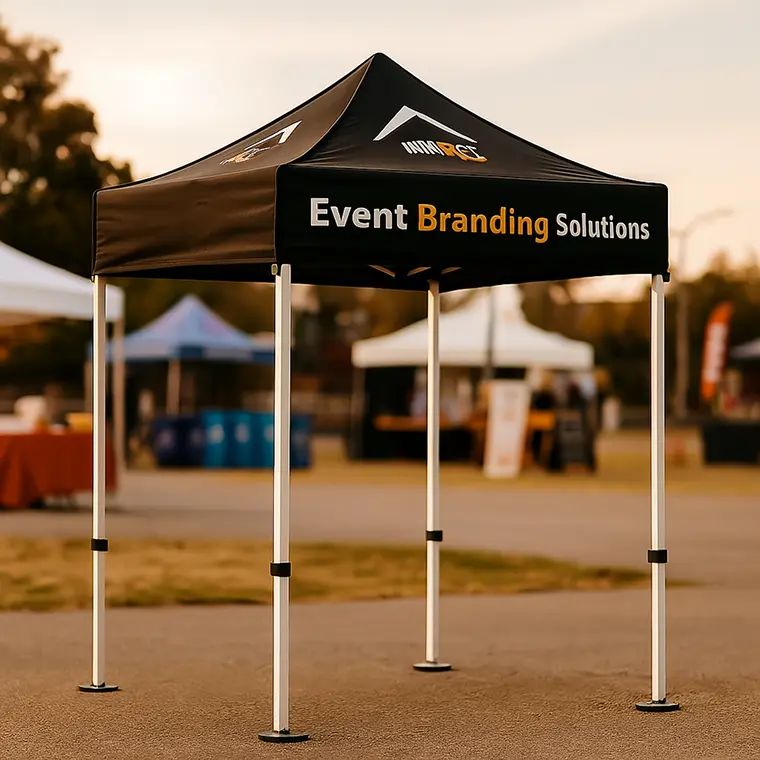
Thank You
Your account is pending approval. You’ll receive a confirmation email once activated.

Custom canopy tents remain one of the most in-demand physical marketing tools, making them a key product in many a reseller’s portfolio. Both a great surface for memorable branding and a practical versatile shelter, it’s a staple at events and promotions.
This guide was specifically created to act as a condensed cheat sheet you can refer to for cornerstone facts when you need to quickly help your clients select the right canopy.
Canopy tents are portable shelters consisting of a frame and a fabric top. The features your clients will need to know to choose the optimal option are the frame material, fabric type, printing quality, and available accessories.
A tent's frame dictates its sturdiness and ease of use. Steel is a strong, and, typically, the most budget-friendly option but it is on the heavier side. Aluminum is lighter, naturally rust-resistant, and often more portable, though it comes at a higher cost. Properly communicating both the pros and the cons when offering canopy tents wholesale, can significantly impact client satisfaction and retention.
| Feature | Steel (e.g., Powder-Coated) | Aluminum (e.g., Anodized) | Main Considerations for Clients |
|---|---|---|---|
| Weight & Portability | Heavier; less ideal for frequent solo transport/setup. | Significantly lighter; excellent for portability and frequent setup/takedown. | How often the client will move the tent and who will be setting it up. For ease of handling, aluminum is superior. |
| Strength & Stability | High inherent strength; good stability when properly anchored. Thinner profiles may be used to manage weight. | Good strength-to-weight ratio; allows for thicker profiles enhancing stability without excessive weight. | A thicker-profile aluminum frame is better for stability with portability. But steel is overall better for stability, especially for more stationary applications. |
| Corrosion Resistance | Relies on coating (e.g., powder coating); susceptible to rust if coating is damaged. | Naturally corrosion-resistant; anodizing further enhances this protection. | When used outdoors in humid, coastal, or long-term outdoor use, aluminum will last better. With steel, corrosion resistance greatly depends on the quality of powder coating. |
| Durability (Lifespan) | Can be very durable if well-maintained and the coating remains intact. Rust is the primary threat to longevity. | Generally a longer lifespan, especially in corrosive environments. | Aluminum often provides better long-term value in harsh conditions. Steel can last long with care, especially in drier climates. |
| Cost | Generally more budget-friendly upfront. | Typically a higher initial investment. | Steel is budget-friendly and strong though with a shorter lifespan; aluminum performs better over time, especially if canopy is used frequently. |
The most popular fabric used for canopy tents is polyester. That’s because it’s a durable, water-resistant material, and stands up great to the sun, even in harsh light. However, while the base material may be the same, the finished covers often greatly differ, depending on how the fabric has been weaved and treated.
This table summarizes fabric characteristics:
| Fabric Type | Key Characteristics | Common Coatings | Waterproof Level | UV Resistance | Tear Strength | Fire Retardancy Potential |
|---|---|---|---|---|---|---|
| Polyester (General) | Durable, lightweight, versatile (available range: 300D, 420D, 500D, 600D). | PU, PVC, Silicone. | Varies from water-resistant to waterproof depending on fabric quality and coating. | Good with UV inhibitors or specialized coatings. | Good, improves with higher denier and quality coatings. | Can be treated to meet CPAI-84, NFPA 701. Certification is key. |
| Oxford Polyester | Specific basket-weave, excellent wear resistance, breathable, durable. Denier ratings similar to general polyester; "double-weave" can enhance performance. | PU coating is common for water resistance. | Can be highly water-resistant to waterproof with good coating. | Good, similar to other polyesters. | Excellent due to weave structure. | Can be treated for fire retardancy. |
| Vinyl Laminated Polyester | Heavy-duty, often with blockout properties. E.g., 14 oz, 16 oz. | Vinyl laminate is inherent. | Generally waterproof. | Good UV resistance often includes UV inhibitors. | Very high tear strength. | Often meets NFPA 701 standards. |
Matching the tent type to your client's needs is critical. Consider their usage frequency, location, and budget.
Easy to recognize with their scissor-like frames. Pop-up canopies are designed for quick setup and portability, so can be a great choice for a client who’s never had to set up one before.
These feature a more robust pole-and-fitting structure, requiring more assembly time but covering larger areas for significant events.
When choosing canopy tent options for clients, steer the conversation toward these vital components to ensure satisfaction: